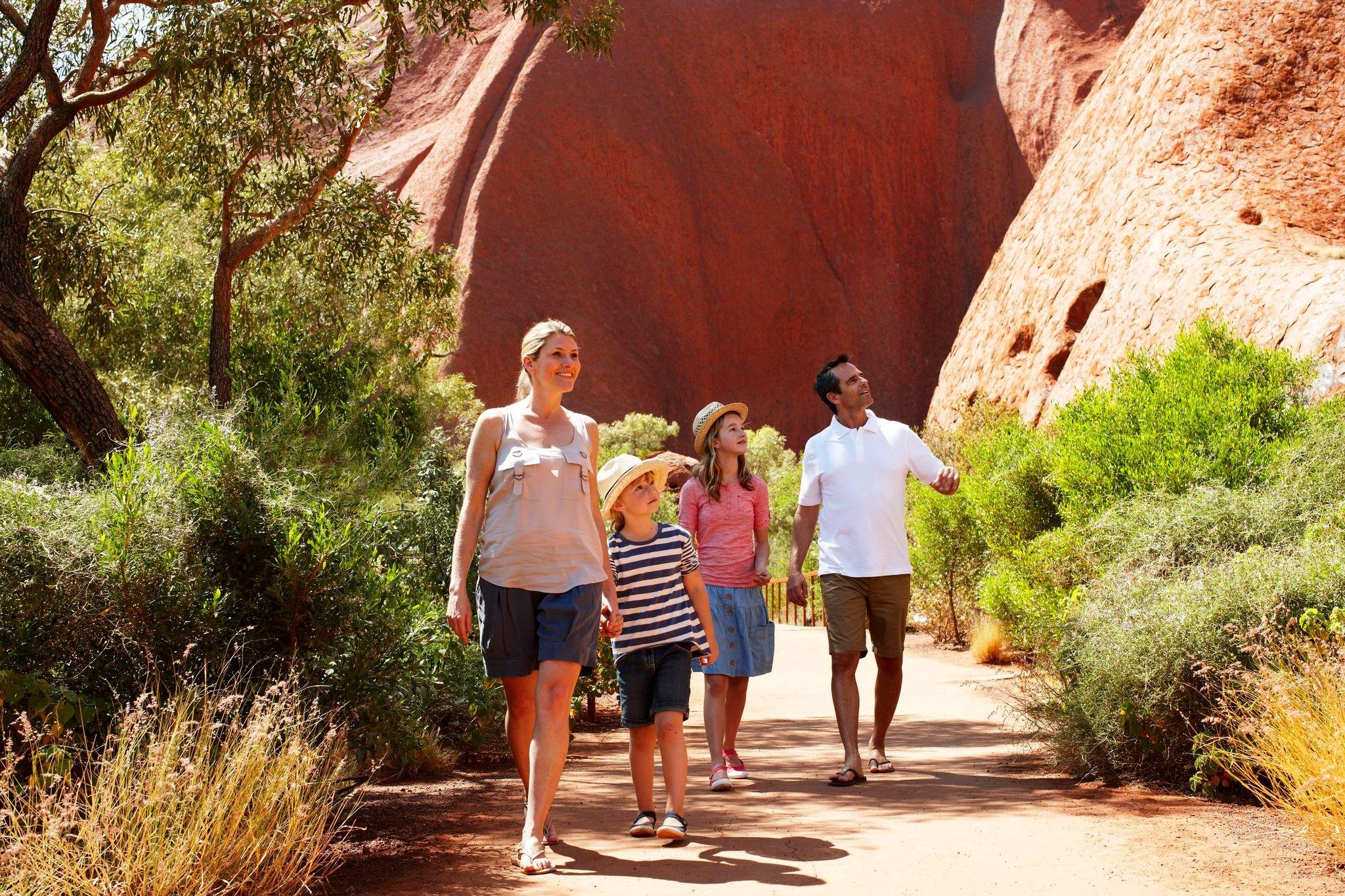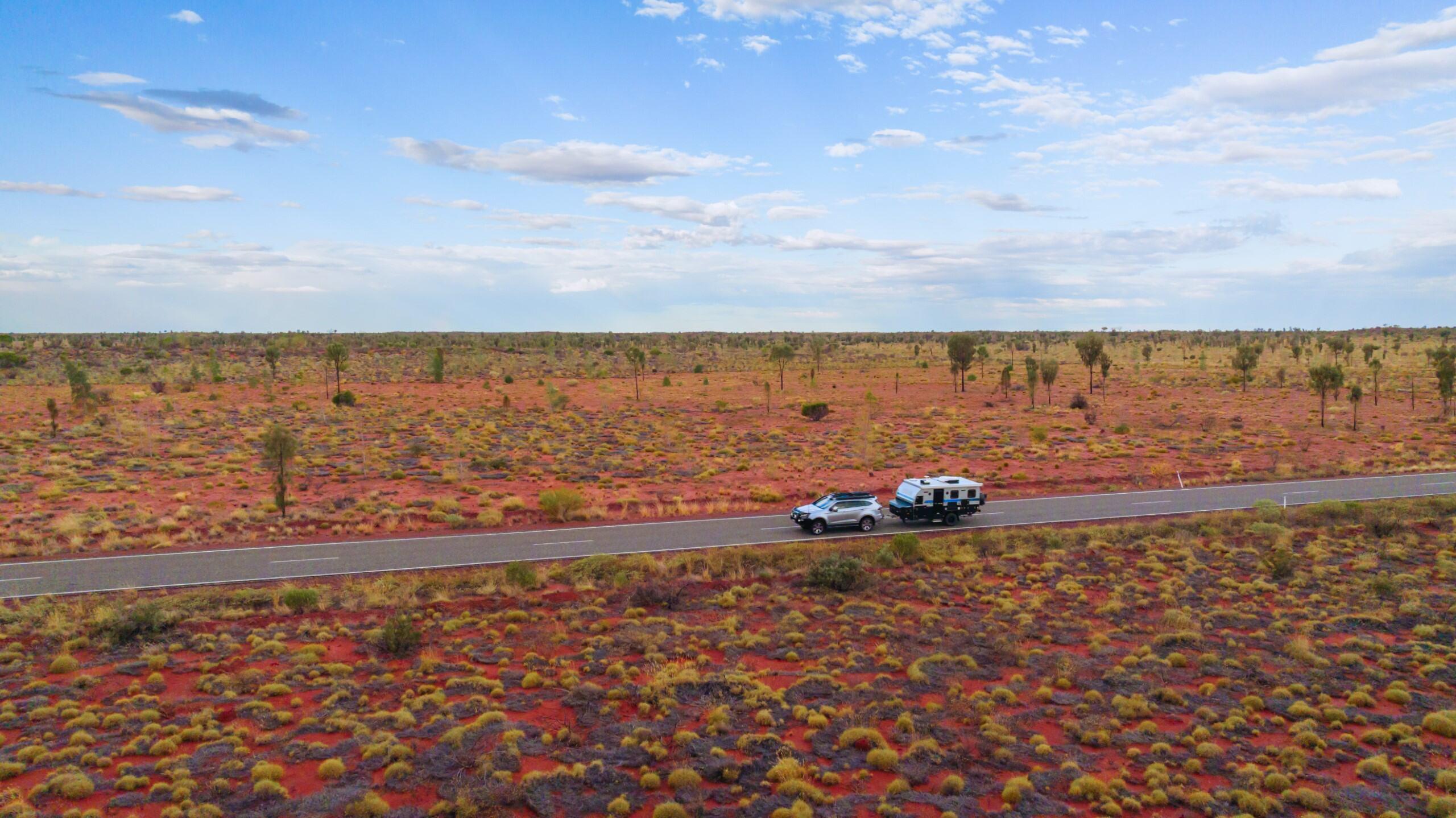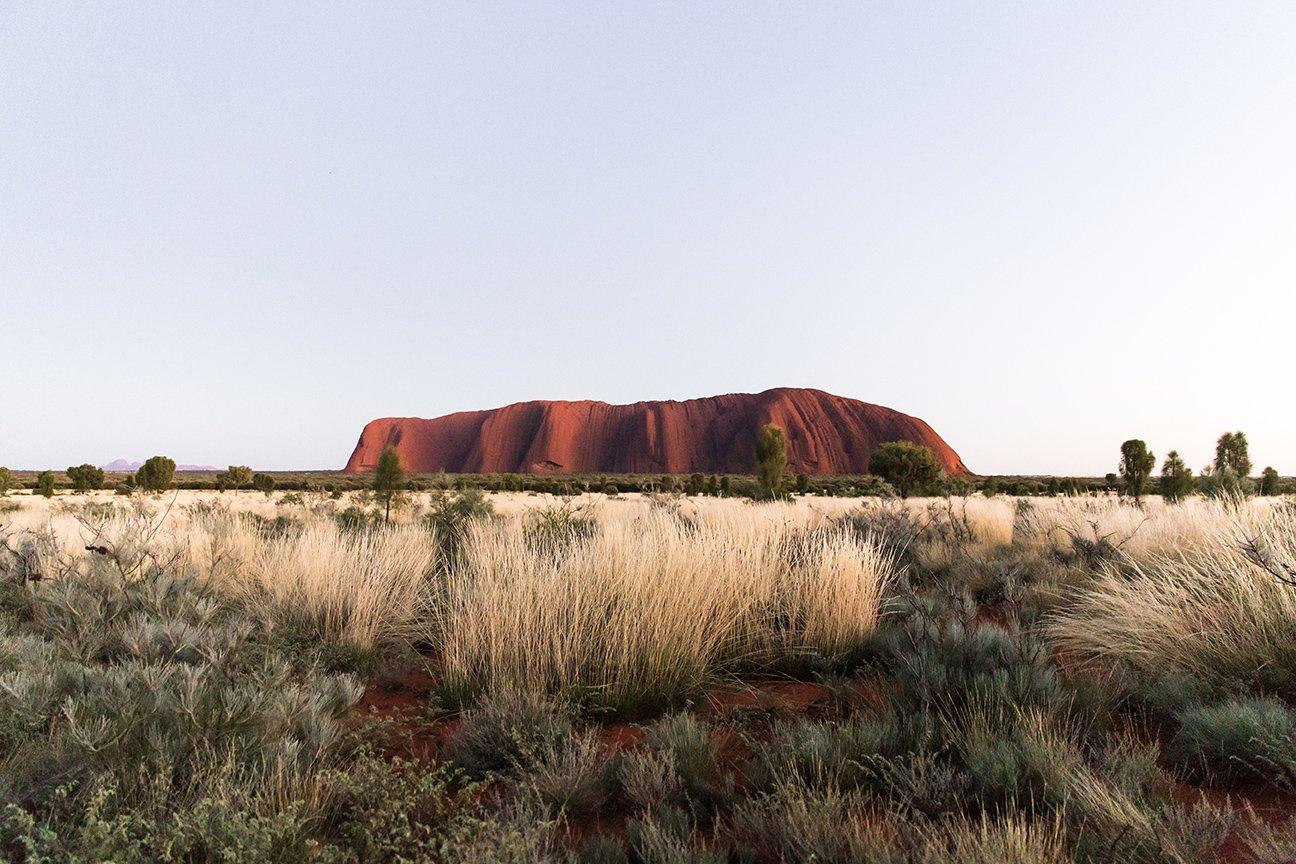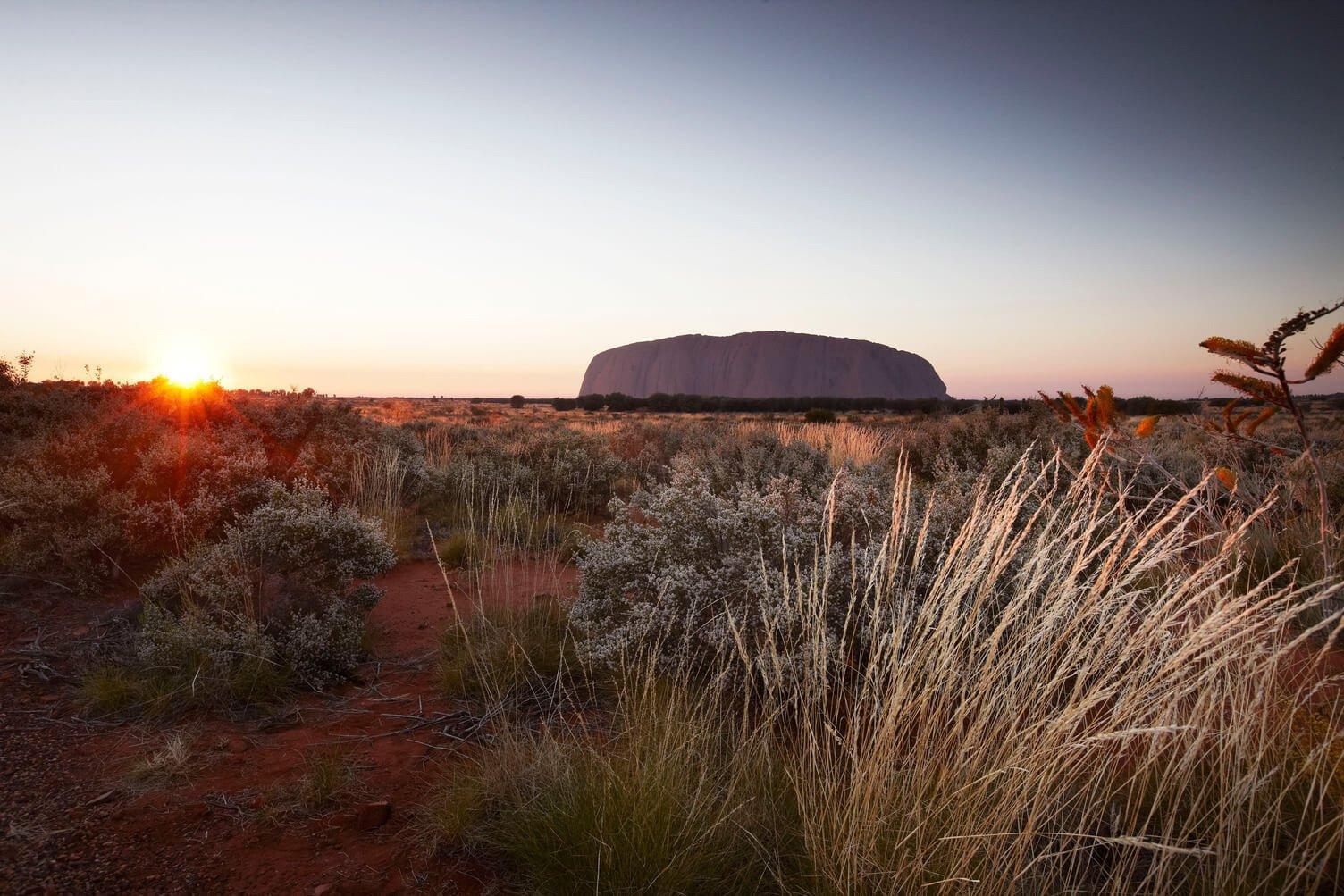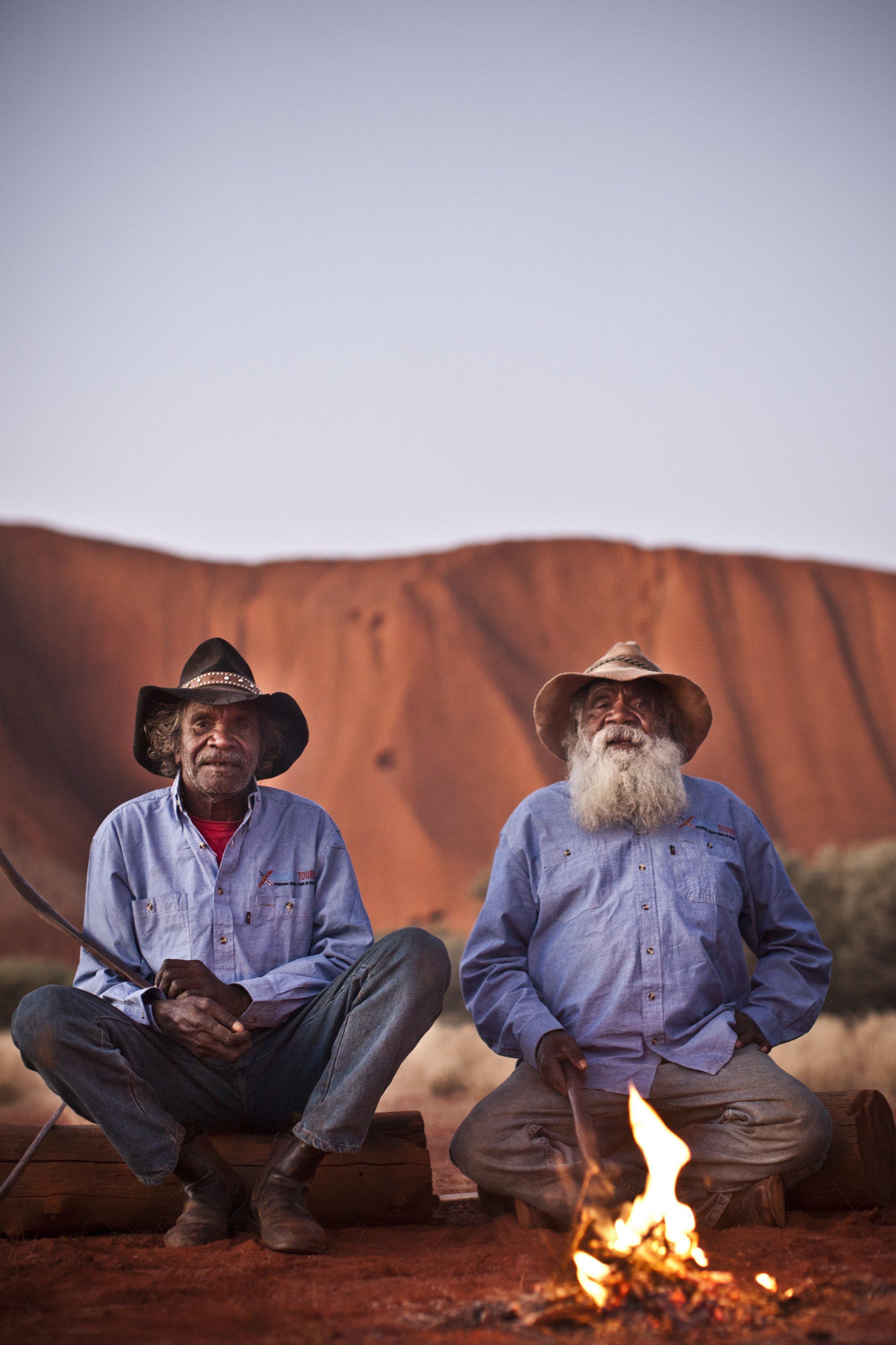Complete Guide to Hiking at Uluru and Kata Tjuta
Hiking around Uluru and Kata Tjuta is one of the most awe-inspiring ways to admire these stunning Australian landmarks. Here are some tips for making the most of your hike in the Red Centre.

Looking for ways to combine sightseeing, fresh air, and physical activity in one fantastic experience? One of the best ways to see Uluru and Kata Tjuta up close is to take a hike around the base of these structures. Climbing is not permitted at Uluru; a base walk or a hike around Uluṟu-Kata Tjuṯa National Park is the perfect way to enjoy some exercise combined with priceless views while learning about the area’s history and cultural significance.
We’re sharing some of our top Uluṟu-Kata Tjuṯa National Park hiking tips for enjoying your outdoor adventure. If this is your first time in Uluṟu-Kata Tjuṯa National Park, this guide will share what to pack, the best time to try hiking, and some helpful safety information to keep in mind. We’ve also rounded up some of the best hiking trails at Uluru for beginners, as well as our favourite trails and Uluru trekking experiences, just for you. Fill up your water bottle, slather on some sunscreen and grab your pack – let’s get started!


Hiking Uluru-Kata Tjuta National Park: What to Know
First and foremost, it’s important to understand the vastness of Uluṟu-Kata Tjuṯa National Park. While Uluṟu and Kata Tjuṯa are both found within the park, they are located about 45 minutes from each other. With this in mind, while it’s possible to visit both in one day, we don’t recommend it. Instead, plan your days and hikes out so you can focus all your time on taking in what each destination has to offer.
Hiking Uluru and Kata Tjuta: What to bring
While exploring Uluru and Kata Tjuṯa walking trails, it’s essential to stay cool and comfortable in the proper clothing – after all, who hasn’t had a great hike spoiled by the sensation of a blister forming, pinching shoes, or being dressed too warmly (or not warmly enough!) One of the most common questions we hear is also one of the easiest to address.
Do I Need Hiking Boots for Uluru and Kata Tjuta?
Simply put, yes! Good shoes or boots are essential for hiking Uluru and Kata Tjuṯa walking trails. Start with sturdy walking shoes or hiking boots layered over comfortable socks – no wrinkles, please! Even though you might be able to traverse some of the hiking trails at Uluru for beginners in light footwear, such as sandals, you’ll want enclosed shoes as the ground is covered with dust and pebbles that could cause discomfort throughout your walk.
Next, choose lightweight, comfortable layers that will keep your body at a proper temperature and provide protection against the sun and pesky insects, too. A light jacket or breathable long-sleeved top and pants are perfect. A broad-brimmed hat is essential. If you’re visiting during the summer months, a fly net is also a good idea.
A high-SPF sunscreen is key (don’t forget to reapply often!) as well as lip balm and sunglasses. Consider insect repellant for summer visits.
Stay hydrated with a refillable water bottle or flask, and pack a portable snack too, such as an energy bar. If you’ve got a pair of binoculars or a camera to capture some of the incredible sights, pop that in your pack as well.
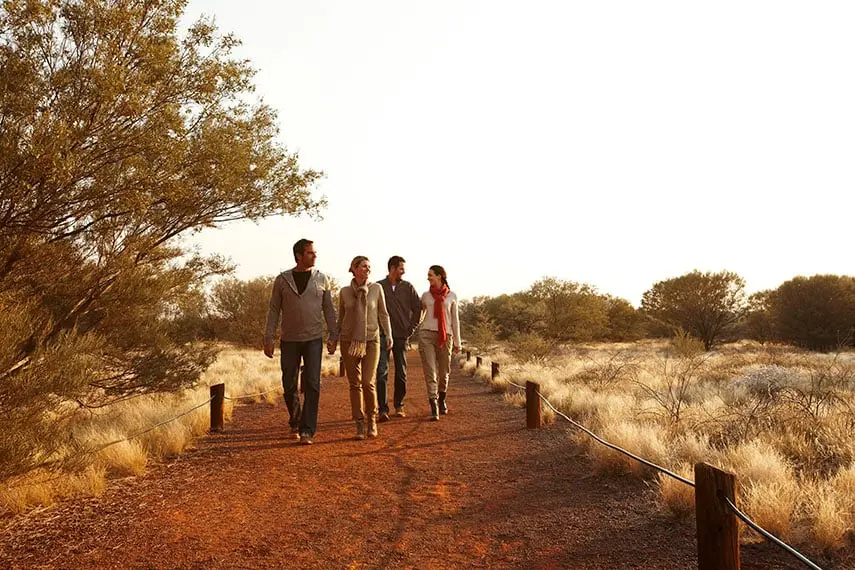

When to head out on a hike
Visiting during the winter months, specifically May through September, is recommended for hiking, biking, and outdoor activities. June and July tend to be the coolest months, with the most comfortable temperatures for hiking – average daily highs are around 18°. Conversely, December and January temperatures soar to about 35° during the day. If you’re visiting during these months, we always recommend getting an early start to your day to make the most of it.
Many guests like to set out for their hikes early in the morning. The sunrise views are spectacular, and there’s something to be said for getting out early, as the rest of the world is just waking up, to enjoy the gorgeous scenery. Generally, it’s not recommended to hike after 11 a.m., especially during the warmer months, due to the rapidly rising temperatures during the day.


Your Questions About Hiking Uluru and Kata Tjuta Answered
Hiking around Uluru and Kata Tjuṯa are fun adventures you’ll want to remember forever, for the right reasons! Here are some common questions about staying safe and making the most of your trek.
How Long Does it Take to Walk Around Uluru?
If you’re wondering how much time to set aside when setting out on the Uluru walking trails, the base walk around Uluru is about 10 kilometres long. Completing the walk takes anywhere from three to three and a half hours.
How Difficult is the Uluru Base Walk?
Because of its length, the Uluru Base Walk is moderately challenging if you are a new hiker. However, completing the entire loop is optional. Beginner hikers can still expect beautiful views from completing smaller sections instead of the loop. Sections of the trek are wheelchair accessible, and it’s a fairly flat course all around.
How Much Water Should I Bring on my Uluru and Kata Tjuṯa Hikes?
Carry and drink one litre of water per person per hour to avoid dehydration. Consider using an electrolyte product to replenish lost fluids if you’re sweating a lot or embarking on an extra-long hike, but caffeinated drinks or sports drinks can be dehydrating and shouldn’t be used in place of water.
How Can I Keep My Energy Up While Hiking Uluru and Kata Tjuṯa?
Most importantly, don’t overdo it: Take lots of breaks, go slower than you think you need to, and don’t wait until you’re hungry to eat something. A hike is not a race, so take your time and enjoy the outing to avoid overexerting yourself.
Can I Explore Off the Trail?
Obey signage: Please stay on marked trails. Not only does this keep you safe, it’s also crucial for protecting the delicate desert ecosystem and respecting Anangu beliefs around the sacred areas of Uluru and Kata Tjuta. Heed all signage and notices, including instructions provided by park rangers.
Can I Walk Around Uluru and Kata Tjuṯa By Myself?
Bring a buddy: Don’t hike alone. Make sure that you bring a hiking partner with you and let someone else know where you’re going and when you expect to return.
What Should I Do if I See an Animal on My Hike?
Give animals space: The Outback is home to plenty of creatures great and small. You’ll want to keep an eye out for the king brown snake, a large, venomous snake that can reach lengths of up to three metres. Generally, it will only bite if it’s disturbed. If you see any snakes in the desert, keep your distance.
The dingo is a wild animal that’s part of the dog family. They’re shy of humans and prefer to prey on small desert animals, but they may watch people from a distance. While they may look cute, they’re wild animals and shouldn’t be approached by humans.
The Best Hiking Trails at Uluru For Beginners
You don’t need to be an expert hiker to experience the beauty of the Red Centre on foot! Here are some easy, accessible paths and trails to check out.
Mala Walk
2km / 1.5 hour return
Beginning at the Mala carpark and continuing to Kantju Gorge, this walk is popular with guided tour groups and is generally quite busy during the day. Kantju Gorge is a lovely spot to catch the sunset at the end of the day. Along this walk, you’ll be able to pop into ancient caves and see the rock art that has decorated the walls for thousands of years.
Kuniya Walk and Mutitjulu Waterhole
1km / 45 minute return
The perfect hike for beginners and guests of all ages, this well-shaded, level track is easy to navigate. You’ll be able to see and hear plenty of birds, and you might spot other wildlife, such as wallabies. The Kuniya walk is a great one during the rainy season as you’ll be able to see gurgling waterfalls. While the Mutitjulu Waterhole is a busy spot in the park, you can visit at sunrise, sunset, or lunchtime for a more solitary experience.
The Best Hiking Trails at Uluru and Kata Tjuta For Experienced Hikers
These hikes are a bit longer and provide a glimpse at some of the unique flora and fauna around Uluru and Kata Tjuta.
Uluru Base Walk
10km / 3.5 hour return
The Uluru Base Walk consists of about 10km of track around the base of the rock. It’s a longer hike, but guests can choose to explore sections of the track rather than the entire loop. However, if you have time, the base walk is a great way to see different landscapes and views, from wide-open spaces to lush, forested areas.
Walpa Gorge Walk
2.6km / 1 hour return
Walpa Gorge is a breathtaking walk lined with plants and flowers and dotted with wildlife – it’s one of the few areas where you can spot wallabies in the wild. To respect Aṉangu culture, please keep both sides of the Gorge visible if you’re capturing it in photos or on video, since this is a very culturally sensitive area.
The Best Hiking Trails at Kata Tjuta For Expert Hikers
When you have more time to spend, this hike is a wonderful way to discover some of the most incredible vistas in the Red Centre.
Valley of the Winds Walk
7km / 4 hour return
This one is more of a trek, but it's worth it if you’re up to the challenge! Here, you’ll be able to see the domes of Kata Tjuta up close. Feel free to photograph them for your own use, but the Aṉangu ask that you be respectful about sharing as this area is very culturally significant to them. This hike has steep, rocky spots so you’ll want to take your time and mind your step.
Ready? Let’s go!
Now that you know when to visit and where to go, the only thing left to do is plan your bucket list adventure! Check out our current special offers or browse other outdoor experiences to round out your unforgettable holiday. We can’t wait for you to explore Uluru and share your favourite moments with us!
To learn more about Uluru Kata Tjuṯa, as well as all the experiences available when you visit Australia’s Red Centre, be sure to explore our Stories.
